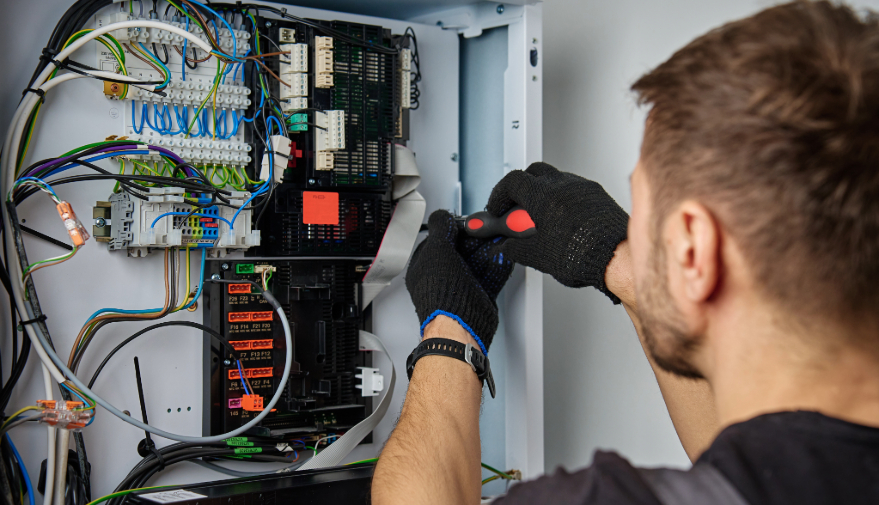HVAC Maintenance Guide: Essential Tools & Software Solutions

Why HVAC Maintenance Is Critical for Commercial and Industrial Environments
HVAC maintenance is a good market to be in, because demand for commercial air conditioning systems is expected to grow at a rate of 7.43% over the next five years. Although your customers might initially be interested in a nice workplace temperature, what they don’t realise is HVAC maintenance offers big business benefits:
- Prevent spiralling costs: as the biggest consumer of energy, air con alone consumes more electricity than all the PCs and office equipment combined. HVAC maintenance ensures everything runs optimally and efficiently to avoid wastage.
- Ensure compliance: commercial buildings must have an Energy Performance Certificate rated E or above. HVAC maintenance can identify where you can make improvements, which ultimately helps your customer avoid a fine of up to £150k.
- Provide a safe working environment: the Health and Safety Executive mandates the minimum workplace temperature be 13°C and not exceed a temperature where heat becomes a hazard. HVAC maintenance ensures employees remain protected and productive.
- Avoid downtime: on average businesses experience 800 hours of unplanned downtime per year. HVAC maintenance allows you to predict where issues are likely to occur and proactively address them before they result in catastrophic failure.
Common Challenges in Managing HVAC Maintenance
HVAC maintenance teams need to be agile to adapt quickly, adjust schedules, send skilled engineers and parts, review and refine ongoing schedules, and more. Without the right service management tools in place, it can feel like you are constantly changing your plans, which can create problems further down the line.
- Inefficient scheduling and tracking: without the right tools, you’ll struggle to match your engineering resources to planned and emergency jobs, and risk assigning engineers with the wrong skills to a job.
- Lack of visibility into asset condition and service history: until you can see every asset, it’s hard to track when equipment needs servicing, which can lead to unexpected repairs or replacements – not great if your customer is on a managed service with SLAs.
- Missed compliance checks and delayed fixes: HVAC compliance in the UK is covered by the Energy Performance of Buildings Directive, which includes TM44 Air Conditioning Inspections, F-Gas Regulations, and the Health and Safety at Work Act. Depending on your contract, non-compliance could land you/your customer in very hot water.
- Communication gaps with mobile engineers: paper-based systems or outdated mobile software can leave your engineers unprepared for first-time fixes. As well as risk getting lost in paperwork, losing customer data, and delaying your ability to issue prompt invoices.
Key Components of an Effective HVAC Maintenance Strategy
Effective HVAC maintenance requires your engineers to perform the following tasks on a regular basis:
- Air filter maintenance
- Coil maintenance
- Ductwork inspection and maintenance
- Thermostat calibration
- Electrical component inspection
- Lubricate moving parts
- System testing under load conditions
But things don’t always go according to plan. Sometimes, without warning or reason, things break, and your engineers need to be on-site right now. Therefore, an effective HVAC maintenance strategy must comprise 3 key elements:
1. Planned Preventive Maintenance (PPM)
PPM keeps HVAC systems in top condition, which reduces the chance of unforeseen breakdowns, improves system safety, and prolongs the lifespan of the equipment. And because the focus is on proactive maintenance, regular check-ups mean your engineers spot potential faults earlier and can fix them before they cause a worst-case scenario.
2. Reactive maintenance
What happens in a heatwave? Employees get all hot and bothered, they crank the air con up to 11, and the unit shuts down. Every. Year. Without. Fail. Some faults, like a blown fuse, refrigerant leak, or clogged drain line, just happen, so you need to be ready and waiting for that call and to assign an engineer to the job.
3. Performance monitoring and asset audits
Monitor data in real-time and you get to know what ‘normal’ looks like. This makes it easier to spot when things aren’t quite where they should be – like rising humidity, airflow, or energy consumption. Depending on your customer, this early detection could have huge implications.
Essential Tools Used in Professional HVAC Maintenance
Every engineer carries a trusty set of tools, as well as an advanced HVAC kit, like a thermometer, core removal, coil fin straightener, multimeter, nitrogen regulator, and leak detector. But then there’s the psychrometer, hand seamers, crimper, awl, flushing solvent, and thermal imaging tools. Plus all the H&S bits, like gloves, masks, googles, and earplugs.
Do they really need a stack of paperwork to carry around too?
The beauty of a mobile app is how your engineers can access everything they need from a pocket-sized tool. And because everything is all together, and all available in real-time, it’s going to streamline, optimise, and speed up every process.

How Software Transforms HVAC Maintenance Operations
While there are many features on offer to support HVAC maintenance, the ones we see having the biggest impact are:
- Automated PPM scheduling and reminders: never miss a service. Prevent breakdowns, minimise costly surprises, and keep your customers’ operations running smoothly.
- Track service history and asset performance: see every job and part history to evaluate efficiency, and develop strategies that improve ROI and extend equipment lifespan.
- Assist with stock & parts management: keep your inventory organised, so your engineers get the parts they need, exactly when they need them, to ensure each service runs without a hitch.
- Improve engineer productivity with mobile apps: keep engineers in sync by enabling them to accept jobs, view detailed instructions, capture images, log time, and raise quotes.
- Enhance compliance tracking and reporting: log refrigerant usage automatically, schedule and record leak detection checks, and generate F-Gas reports instantly to simplify audits.
Benefits of Using HVAC Maintenance Software
There are many benefits in using software to support HVAC maintenance, including:
- Cut operating costs and reduce wastage
- Optimise scheduling and dispatching
- Boost productivity and efficiency for field teams
- Keep customers informed in real-time
- Improve cash flow with faster invoicing
What to Look for in HVAC Maintenance Software
Choosing the right HVAC maintenance software for your business can feel daunting – particularly when you’re faced with several providers all saying similar things. Our advice is to:
- Understand your business needs
- Focus on features that benefit your business
- Ensure the software integrates with your existing systems
And make sure any tool you choose contains the following as standard:
Asset management features
Get a complete picture of each piece of equipment with asset management – including a detailed record for parts and job history, so you can fully understand its lifecycle, performance, profitability, and depreciation, and ensure nothing is overlooked.
Mobile engineer access
Keep your engineers connected with a mobile app to give real-time access to job details, updates, and essential forms while they’re on the go. This immediate access ensures prompt action and clear communication, keeping workflows efficient and reducing delays.
Integration with inventory/parts tracking
Automate parts tracking and replenishment to efficiently manage your inventory for smooth maintenance operations across multiple depots. As well as help engineers to locate parts quickly, it reduces manual errors, optimises your inventory, and keeps every part accounted for.
Real-time dashboards and custom reports
Trust in the numbers with a real-time snapshot of what’s going on – from profit margins and performance through to equipment downtime, first-time fix rates, and workforce productivity. Spot trends early, tackle inefficiencies before they escalate, and keep your business on track.
Future-Proofing Your HVAC Operations with Smart Maintenance
The future is all about IOT sensors and how their data-driven insights support energy management, efficiency, and sustainability. With data, you can track energy consumption, pinpoint areas for improvement, and recommend strategies that reduce overall energy usage, which is ultimately going to give your customers better service, your engineers a hassle-free schedule, and your business a competitive edge as it scales.
Ready to Improve Your HVAC Maintenance Strategy?
Managing HVAC maintenance, tracking assets, and staying compliant shouldn’t be a struggle. With Service Geeni's service management software, it’s now possible to connect your engineers, data, and workflows - so your HVAC service operation runs efficiently.
Alternatively, why not see what Service Geeni can do for you?
Download Full PDF
Read More…

Book Your Demo Today







